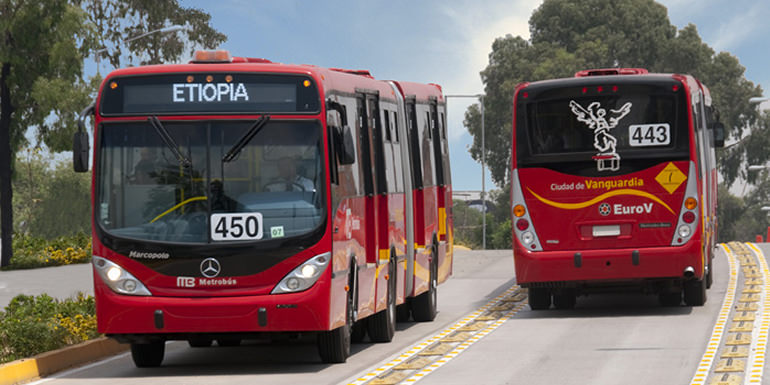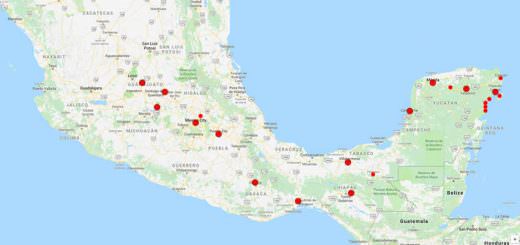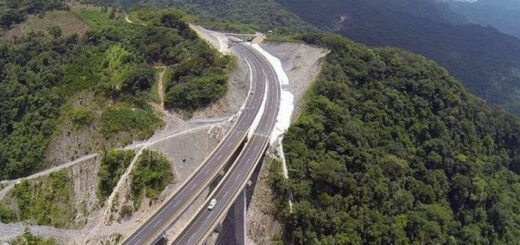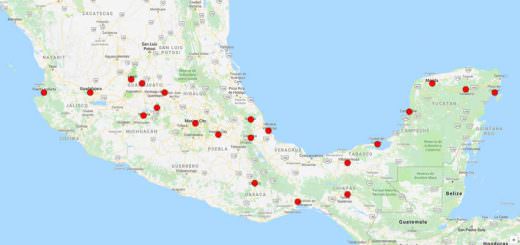
Mexico has developed an extensive transportation network to meet the needs of the economy.
As with communications, transportation in Mexico is regulated by the Secretariat of Communications and Transportation, (Secretaría de Comunicaciones y Transportes, SCT) a federal executive cabinet branch.
Roadways
The roadway network in Mexico is extensive and all areas in the country are covered by it.
The roadway network in Mexico has an extent of 366,095 km, of which 116,802 km are paved, making it the largest paved roadway network in Latin America. Of these, 10,474 km are multi-lane expressways: 9,544 km are four-lane highways and the rest have 6 or more lanes.
The highway network in Mexico is classified by number of lanes and type of access.
The great majority of the network is composed of undivided or divided 2-lane highways with or without shoulders (known as carreteras). Four or more lane freeways or expressways, with restricted or unrestricted access (known as autopistas).
Speed limits on two-lane highways can vary depending on terrain conditions. The speed limit in multi-lane freeways or expressways is on average 110 km/h for automobiles and 95 km/h for buses and trucks.
- The expressways are, for the most part, toll roads or autopistas de cuota.
- Non-toll roads are referred to as carreteras libres, or free roads.
Most toll expressways have emergency telephone booths, water wells, and emergency braking ramps at short intervals.
The toll usually includes a “travelers’ insurance” (seguro del viajero) should an accident occur within the freeway. The tolls are, on average, among the most expensive in the world, according to a comparative study realized in 2004 by the Chamber of Deputies.
The most traveled freeways are those that link the three most populous cities in Mexico: Mexico City, Guadalajara, and Monterrey, in the form of a triangle.
No federal freeway or expressway crosses a city. Toll expressways are either turned into toll bypasses (libramientos) often used as toll or free ring roads (periféricos), or are transformed into major arterial roads, even if they are, in function, freeways with restricted access.
Mexican highways are assigned a one to three-digit number. North-south highways are assigned odd numbers whereas east-west highways are assigned even numbers. Toll expressways usually run parallel to a free road, and therefore, are assigned the same number with the letter “D” added. (For example, the undivided two-lane highway connecting Mexico City and Puebla is MX 150, whereas the six-lane toll expressway is MX 150D).
Mexico has had difficulty in building an integrated highway network due to the country’s orography and landscape characteristics, most of the country is crossed by high-altitude ranges of mountains. Over the last two decades, Mexico has made impressive investments in order to improve its road infrastructure and connect main cities and towns across the country. In spite of its extension and recent development, the roadway network in Mexico is still inadequate to meet the current needs of the population and, except for the toll roads, they are often not adequately maintained.
An additional problem is that in the center of the country, the roads run into metropolitan Mexico City from regional centers and there are few roads that run peripherically so as to connect the other regional centers without running through the congestion around the capital. The federal government (in partnership with the government of Mexico State and the Federal District) has tried to alleviate this problem by constructing a tolled Mexico City bypass highway, named “Arco Norte,” which partially opened in 2009.
Railroads
Mexico privatized its rail service with the dissolution of the former Ferrocarriles Nacionales de México in 1998. There is a Mexico City Metro and a Monterrey Metro as well as light rail systems operating in Mexico City (Xochimilco Light Rail), and Guadalajara (Guadalajara light rail system).
The Secretariat of Communications and Transport of Mexico has proposed a high-speed rail link that would transport passengers from Mexico City to Guadalajara, Jalisco, with stops in the cities of Querétaro, Guanajuato, Leon, and Irapuato; and a connected line running from the port city of Manzanillo to Aguascalientes. The train, which would travel at 300 km/h, allows passengers to travel from Mexico City to Guadalajara in just 2 hours (the same trip by road would last 7 hours).
Airports and air travel
Mexico has an extensive network of modern airports all throughout the territory; flying domestically is considered efficient and safe. Airport infrastructure in Mexico is the most advanced in Latin America: all the cities with more than 500,000 inhabitants have an airport. There are 1834 airports in Mexico, the third-largest number of airports by country in the world. The seven largest airports—which absorb 90% of air travel—are (in order of air traffic): Mexico City International Airport, Cancún International Airport, Don Miguel Hidalgo y Costilla International Airport (Guadalajara), General Mariano Escobedo International Airport (Monterrey), General Abelardo L. Rodríguez International Airport (Tijuana), General Juan N. Álvarez International Airport (Acapulco), and Lic. Gustavo Díaz Ordaz International Airport (Puerto Vallarta). All airports are privately owned, with the exception of Mexico City International Airport. This airport remains the largest in Latin America and the 44th largest in the world transporting close to 26 million passengers a year.
There are more than 70 domestic airline companies in Mexico. The major player in the industry is Aeroméxico, owned by Grupo Financiero Banamex. Mexicana de Aviación, the oldest airline in Mexico, was the second player in the industry until it ceased operations in August 2010. Other small airlines include Aeroméxico Connect (Aeromexico regional subsidiary), Click Mexicana (Mexicana’s low-cost subsidiary), Aviacsa, Volaris, Interjet, Aeromar, VivaAerobus, Magnicharters and Republicair.
The governments of the United States and Mexico recently approved an agreement of “open skies”, which allows low-cost carriers to operate point-to-point (direct) routes between American and Mexican cities. This will decentralize air traffic in North America by bypassing major hubs and connecting smaller cities directly.
Seaports
Mexico has 76 seaports and 10 river ports. The four major seaports concentrating around 60% of the merchandise traffic are Altamira and Veracruz in the Gulf of Mexico, and Manzanillo and Lázaro Cárdenas in the Pacific Ocean. These four seaports are followed in traffic by Acapulco, Puerto Vallarta, Guaymas, Tampico, Topolobambo, Mazatlán, and Tuxpan.

Download Mexico City Metro Map (.pdf)
Mexico City Metro
The Mexico City Metro (Metro de la Ciudad de México), officially called Sistema de Transporte Colectivo, often shortened to STC, is a metro system that serves the metropolitan area of Mexico City, including some municipalities in Mexico State.
It is the second largest metro system in North America after the New York City Subway. In 2015, the system served 1.623 billion passengers, placing it as the ninth-highest ridership in the world.
The inaugural STC Metro line was 12.7 kilometers long, serving 16 stations, and opened to the public on September 4, 1969.
As of 2015, the system has 12 lines, serving 195 stations, and 226.49 kilometres (140.73 mi) of route (including the recently opened Line 12).
Many stations are named for historical figures, places, or events in Mexican history.
Ten of the lines are rubber-tired; instead of traditional steel wheels, they use pneumatic traction, which is quieter and copes better with Mexico City’s unstable soils. The system survived the 1985 Mexico City earthquake.
Of the STC Metro’s 195 stations, 24 serve two or more lines (correspondencias or transfer stations). It has 115 underground stations (the deepest of which are 35 meters below street level); 54 surface stations and 26 elevated stations. All lines operate from 5:00 to 0:00.
At the end of 2007, the Federal District government announced the construction of the most recent STC Metro line, Line 12, which was built to run approximately 26 kilometers towards the southeastern part of the city, connecting with Lines 7, 3, 2, and 8. This line opened on October 30, 2012.
The Metro has figured in Mexico’s cultural history, as the inspiration for a musical composition for strings, “Metro Chabancano” and the 1982 Rodrigo “Rockdrigo” González’s 1982 song, “Metro Balderas.” It has also been a site for the 1990 Hollywood movie Total Recall. Public intellectual, Carlos Monsiváis has commented on the cultural importance of the Metro, “a space for collective expression, where diverse social sectors are compelled to mingle every day.”
History
Concept of the Metro and Early Plans
By the second half of the twentieth century, Mexico City had serious public transport issues, with congested main roads and highways, especially in the downtown zone, where 40 percent of the daily trips in the city were concentrated. 65 of the 91 lines of bus and electric transport served this area. With four thousand units in addition to 150,000 personal automobiles peak hours, the average speed was less than the walking pace.
The principal promoter of the construction of the Mexico City Metro was engineer Bernardo Quintana, who was in charge of the construction company Ingenieros Civiles y Asociados (Spanish for Civil Engineers and Associates). He carried out a series of studies that resulted in a draft plan that would ultimately lead to the construction of the Mexico City Metro. This plan was shown to different authorities of Mexico City but it was not made official until April 29, 1967, when the Government Gazette (“Diario Oficial de la Federación”) published the presidential decree that created a public decentralized organism, the Sistema de Transporte Colectivo, with the proposal to build, operate and run a rapid transit of subterranean course for the public transport of Mexico City.
On June 19, 1967, at the crossroads of Chapultepec Avenue with Avenida Bucareli, the inauguration ceremony for the Mexico City Metro took place. Two years later, on September 4, 1969, an orange train made the inaugural trip between stations Zaragoza and Insurgentes, thus beginning daily operation up to today.
First stage (1967–1972)
The first stage of construction comprised the construction and inauguration of lines 1, 2, and 3.
This stage involved engineers, geologists, mechanics, civil engineers, chemists, hydraulic and sanitation workers, electricians, archaeologists, and biologists; specialists in ventilation, statistics, computation, and traffic and transit; accountants, economists, lawyers, workers, and laborers.
Between 1,200 and 4,000 specialists and 48,000 workers participated, building at least one kilometer of track per month, the fastest rate of construction ever for a subway.
During this stage of construction workers uncovered two archaeological ruins, one Aztec idol, and the bones of a mammoth (under exhibit in Talismán station).
By the end of the first stage, namely on June 10, 1972, the STC Metro had 48 stations and a total length of 41.41 kilometers: Line 1 ran from Observatorio to Zaragoza, Line 2 from Tacuba into the southwestern Tasqueña and Line 3 from Tlatelolco to Hospital General in the south, providing quick access to the General Hospital of Mexico.
Second stage (1977–1982)
No further progress was reached during President Luis Echeverría’s government, but during José López Portillo’s administration, a second stage began. The Comisión Ejecutiva del Metro (Executive Technical Commission of Mexico City Metro) was created in order to be in charge of expanding the STC Metro within the metropolitan area of Mexico City.
Works began with the expansion of Line 3 towards the north from Tlatelolco to La Raza in 1978 and to the current terminal Indios Verdes in 1979, and towards the south from Hospital General to Centro Médico in 1980 and to Zapata months later. Construction of lines 4 and 5 was begun and completed on May 26 and August 30, 1982, respectively; the first one from Martín Carrera to Santa Anita and the latter from Politécnico to Pantitlán. Line 4 was the first STC Metro line built as an elevated track, owing to the lower density of big buildings.
Third stage (1983–1985), and the 1985 earthquake
This construction stage took place from the beginning of 1983 through the end of 1985. Lines 1, 2, and 3 were expanded to their current lengths, and new lines 6 and 7 were built. The length of the network was increased by 35.29 kilometers and the number of stations to 105.
Line 3 route was expanded from Zapata station to Universidad station on August 30, 1983. Line 1 was expanded from Zaragoza to the current terminal Pantitlán, and line 2 from Tacuba to the current terminal Cuatro Caminos. These latter were both inaugurated on August 22, 1984.
Line 6 first route ran from El Rosario to Instituto del Petróleo; Line 7 was opened from Tacuba to Barranca del Muerto and runs on the bottom of the Sierra de las Cruces mountain range that surrounds the Valley of Mexico by its west side, outside of the ancient lake zone. This made it possible for Line 7 to be built as a deep tunnel.
On the morning of September 19, 1985, an 8.1 Richter magnitude earthquake struck Mexico City. Many buildings as well as streets were left with major damage making transportation on the ground difficult, but the STC Metro was not damaged because a rectangular structure had been used instead of arches, making it resistant to earthquakes, thus proving to be a safe means of transportation in a time of crisis.
On the day of the quake, the Metro stopped service and completely shut down for fear of electrocution. This caused people to get out of the tunnels from wherever they were and onto the street to try to get where they were going. At the time, the Metro had 101 stations, with 32 closed to the public in the weeks after the event. On Line 1, there was no service in stations Merced, Pino Suárez, Isabel la Católica, Salto del Agua, Balderas or Cuauhtémoc. On Line 2, there was no service between stations Bellas Artes and Taxqueña. On Line 3 only Juárez and Balderas were closed. Line 4 continued to operate normally. All of the closed stations were in the historic center area, with the exception of the stations of Line 2 south of Pino Suárez. These stations were located above ground. The reason these stations were closed was not due to damage to the Metro proper, but rather because of surface rescue work and clearing of debris.
Fourth stage (1985–1987)
The fourth stage saw the completion of Line 6 from Instituto del Petróleo to the eastern terminal of Martín Carrera and Line 7 to the north from Tacuba to El Rosario. Line 9 was the only new line built during this stage. It originally ran from Pantitlán to Centro Médico and its expansion to Tacubaya was completed on August 29, 1988. For Line 9, a circular deep tunnel and an elevated track were used.
Fifth stage (1988–1994)
For the first time, a service line of the Mexico City Metro ran into the State of Mexico: planned as one of more líneas alimentadoras (feeding lines to be named by letters, instead of numbers), line A was fully operational by its first inauguration on August 12, 1991. It runs from Pantitlán to La Paz, located in the municipality of the same name. This line was built almost entirely above ground, and to reduce the cost of maintenance, steel railway tracks and overhead lines were used instead of pneumatic traction, promoting the name metro férreo (steel-rail metro) as opposed to the previous eight lines that used pneumatic traction.
The draft for Line 8 planned a correspondencia (transfer station) in Zócalo, namely the exact center of the city, but it was canceled due to possible damage to the colonial buildings and the Aztec ruins, so it was replanned and now it runs from Garibaldi, which is still downtown, to Constitución de 1917 in the southeast of the city. The construction of line 8 began in 1988 and was completed in 1994.
With this, the length of the network increased by 37.1 kilometers, adding two lines and 29 more stations, giving the metro network at that point a total of 178.1 kilometers, 154 stations, and 10 lines.
Sixth stage (1994–2000)
Assessment for line B began in late 1993. Line B was intended as a second línea alimentadora for northeastern municipalities in the State of Mexico, but, unlike line A, it used pneumatic traction. Construction of the subterranean track between Buenavista (named after the old Buenavista train station) and Garibaldi began in October 1994. Line B was opened to the public in two stages: from Buenavista to Villa de Aragón on December 15, 1999, and from Villa de Aragón to Ciudad Azteca on November 30, 2000.
Seventh stage (2008–2014)
Plans for a new STC Metro line started in 2008, although previous surveys and assessments were made as early as 2000. Line 12 first service stage was planned for completion in late 2009 with the creation of track connecting Axomulco, a planned new transfer station for Line 8 (between Escuadrón 201 and Atlalilco) to Tláhuac. The second stage, connecting Mixcoac to Tláhuac, was to be completed in 2010.
Construction of Line 12 started in 2008, assuring it would be opened by 2011. Nevertheless, completion was delayed to 2012. Free test rides were offered to the public in some stations, and the line was fully operational on October 30, 2012. With minor changes, Line 12 runs from Mixcoac to Tláhuac, serving southern Mexico City for the first time. With 24.31 kilometers, it is the longest line in the system.
Line 12 differs from previous lines in several aspects: no hawkers are allowed, neither inside the train nor inside the stations; it is the first numbered line to use steel railway tracks; one must have a Tarjeta DF smart card to access any station since Metro tickets are no longer accepted.
In the book Los hombres del Metro, the original planning of Line 12 is described; although it was to begin at Mixcoac as it does today, Atlalilco and Constitución de 1917 stations of Line 8 were to be part of Line 12. The same map shows that Line 8 would have reached the Villa Coapa area and that it would not have had a terminal at Garibaldi, but at Indios Verdes, linking with Line 3. In addition, the book shows that Line 7 would have terminated at San Jerónimo. None of these plans have been confirmed by the Mexico City government.
In 2015 Mayor Miguel Ángel Mancera announced the construction of two more stations and a terminal for Line 12: Valentín Campa, Álvaro Obregón, and Observatorio, both west of Mixcoac; these are to be built by 2016. With this Line 12 will be connected to Line 1 and provide new metro access to the Observatorio zone, which will become the terminal for the intercity train between México City and Toluca, planned to be completed in 2018.
Archaeological Findings
The metro system’s construction has resulted in more than 20 thousand archeological findings, from various time periods in the history of the indigenous people. The excavations needed to make way for the rails gave opportunities to find artifacts from different periods of the region’s inhabitants, in areas that are now densely urbanized. Objects and small structures were found, with origins spanning from prehistoric times to the 20th century. Some examples of artifacts preserved by the Mexican National Institute of Anthropology and History (Instituto Nacional de Antropología e Historia de México (INAH)) are: parts of pyramids (like an altar to the Mexica god Ehecatl), a sculpture of the goddess Coatlicue, and remains of a mammoth. The altar to Ehécatl is now in Pino Suárez station, between lines 1 and 2, and is called by the INAH the smallest archeological site in Mexico. The metro has led to a large quantity of archeological findings and has also let us understand more about the pattern of ancient civilizations in the Mexican capital by analyzing its underground from various time periods.
Architecture
Distinguished architects were hired to design and construct the stations on the first metro line, such as Enrique del Moral, Félix Candela, Salvador Ortega, and Luis Barragán. Examples of Candela’s work can be seen in San Lázaro, Candelaria, and Merced stations on line 1.
Lines, stations, names, colors, and logos
Each line offers one service only, and to each line a number (letter if feeding line) and a color are assigned.
Every assigned color is present on square-shaped station logos, system maps, and street signs, and neither colors nor numbers have been changed.
Line B is the only exception to color assignment, as green (upper half) and grey (lower half) are used, producing bicolor logos and signs. Gray only may be used to avoid confusion with line 8, which uses a similar green.
The names of metro stations are often historical in nature, highlighting people, places, and events in Mexican history.
There are stations commemorating aspects of the Mexican Revolution and the revolutionary era.
When it opened in 1969 with line 1 (the “Pink Line”), two stations alluded to the Revolution.
Most directly referencing the Revolution was Metro Pino Suárez, named after Francisco I. Madero’s vice president, who was murdered with him in February 1913.
The other was Metro Balderas, whose icon is a cannon, alluding to the Ciudadela armory where the coup against Madero was launched.
In 1970, Metro Revolución opened, with the station at the Monument to the Revolution.
As the Metro expanded, further stations with names from the revolutionary era opened.
In 1980, two popular heroes of the Revolution were honored, with Metro Zapata explicitly commemorating the peasant revolutionary from Morelos.
A sideways commemoration was Metro División del Norte, named after the Army that Pancho Villa commanded until its demise in the Battle of Celaya in 1915.
The year 1997 saw the opening of the Metro Lázaro Cárdenas station.
In 1988, Metro Aquiles Serdán honors the first martyr of the Revolution Aquiles Serdán.
In 1994, Metro Constitución de 1917 opened, as did Metro Garibaldi, named after the grandson of Italian fighter for independence, Giuseppi Garibaldi. The grandson had been a participant in the Mexican Revolution.
In 1999, the radical anarchist Ricardo Flores Magón was honored with the Metro Ricardo Flores Magón station. Also opening in 1999 was Metro Romero Rubio, named after the leader of Porfirio Díaz’s Cientificos, whose daughter Carmen Romero Rubio became Díaz’s second wife.
In 2012, a new Metro line opened with a Metro Hospital 20 de Noviembre stop, a hospital named after the date that Francisco I. Madero in his 1910 Plan de San Luis Potosí called for rebellion against Díaz.
There are no Metro stops named for Madero, Carranza, Obregón, or Calles and only an oblique reference to Villa in Metro División del Norte.
Each station is identified by a minimalist logo, first designed by Lance Wyman, who had also designed the logo for the 1968 Mexico Olympics. Logos are generally related to the name of the station or the area around it.
At the time of Line 1’s opening, Mexico’s illiteracy rate was high. As of 1960, 38% of Mexicans over the age of five were illiterate and only 5.6% of Mexicans over the age of six had completed more than six years of school. Since one-third of the Mexican population could not read or write and most of the rest had not completed high school, it was thought that patrons would find it easier to guide themselves with a system based on colors and visual signs.
The logos are not assigned at random; rather, they are designated by considering the surrounding areas, such as:
1. The reference places that are located around the stations (e.g., the logo for Salto del Agua fountain depicts a fountain).
2. The topology of an area (e.g., Coyoacán—in Nahuatl “place of coyotes”—depicts a coyote).
3. The history of the place (e.g., Juárez, named after President Benito Juárez, depicts his silhouette).
The logos’ background colors reflect those of the line the station serves. Stations serving two or more lines show the respective colors of each line in diagonal stripes, as in Salto del Agua.
This system was adopted for the Guadalajara and Monterrey metros, and recently for the 2005, 2009 and 2011 Mexico City Metrobús. Although logos are no longer necessary due to literacy being now widespread, their usage remains.
Transfers to other systems
The Mexico City Metro offers in and out-street transfers to three major rapid transit systems: the Mexico City Metrobús bus rapid transit system, the Mexico City light rail system, and the Ferrocarril Suburbano (FSZMVM) commuter rail. None of these is part of the Sistema de Transporte Colectivo network and an extra fare must be paid for access.
Metrobús Line 1 was inaugurated in 2005. According to the 1985 STC Metro Master Plan, Metrobús Line 1 roughly follows the route planned for STC Metro Line 15 by 2010, which was never built. Every transfer is out-of-station, but the same smart card may be used for payment. All five lines (Line 5 to be built during 2013) offer connection to at least one STC Metro station. STC Metro stations that connect to Metrobús lines include Indios Verdes, La Raza, Chilpancingo, Balderas, Etiopía / Plaza de la Transparencia, Insurgentes Sur, and others.
The sole light rail line running from Tasqueña to Xochimilco is operated by the Servicio de Transportes Eléctricos and is better known as Tren Ligero. Line 2 terminal Tasqueña offers an in-station transfer, but an extra ticket must be purchased.
In 2008, the Ferrocarril Suburbano commuter rail, commonly known as Suburbano, was inaugurated with a sole line running from Cuatitlán to Buenavista in 2013. STC Metro offers two in-station transfers: Line B terminal Buenavista to the Suburbano terminal of the same name, and Line 6 station Ferrería / Arena Ciudad de México into Suburbano station Fortuna. An extra fare must be paid, and a Ferrocarril Suburbano smart card is required for access.
Another commuter rail, Tren Interurbano de Pasajeros Toluca-Valle de México will be completed in 2018. This line will connect Mexico City with Toluca. It will terminate at Metro Observatorio.
Fares and pay systems
The price for a single-day ticket is currently MXN $5.00. A discounted rate of MXN $3.00 is available upon application for women heads of households, the unemployed, and students with scarce resources. Mexico City Metro offers free service to the elderly, the physically impaired, and children under the age of 5 (accompanied by an adult). Tickets can be purchased at booths.
Until 2009, an STC Metro ticket cost MXN $2.00 (€ 0.10, or US$ 0.15 in 2009); one purchased ticket allowed unlimited distance travel and transfer at any given time for one day, making the Mexico City Metro one of the cheapest rail systems in the world. Only line A’s transfer in Pantitlán required a second payment before December 13, 2013. In January 2010 the price rose to MXN $3.00 (€ 0.15, or US$ 0.24), a fare that remained until December 13, 2013; a 2009 survey showed that 93% of citizens approved of the increase, while some said they would be willing to pay even more if needed.
STC Metro rechargeable cards were first available for an initial cost of MXN $10.00. The card would be recharged at the ticket counter in any station (or at machines in some Metro stations) to a maximum of MXN $120.00 (around € 6.44, or US$ 7.05 in 2015) for 20 trips.
In an attempt to modernize public transport, in October 2012 the Mexico City government implemented the use of a prepaid fare card, or stored-value card, called Tarjeta DF (Tarjeta del Distrito Federal, literally Federal District Card) as a payment method for STC Metro, Metrobús and the city’s trolleybus and light rail systems, though they are all managed by different organizations. Servicio de Transportes Eléctricos manages both the Xochimilco Light Rail line and the city’s trolleybus system. Previous fare cards that were valid only on STC Metro or Metrobús remained valid for the system for which they were acquired.
Rolling stock
As of April 2012, 14 types of standard gauge rolling stock totaling a number of 355 trains running in 6- or 9-car formations are currently in use on the Mexico City Metro. Four manufacturers have provided rolling stock for the Mexico City Metro, namely the French Alstom (NM-73, 79), Canadian Bombardier (MP-86, FM-95A, and NM-02), Spanish CAF, and Mexican Concarril (NM-83 and FM-86) (now Bombardier Transportation Mexico, in some train types with the help of Alstom and/or Bombardier).
The maximum design speed limit is 80 km/h (50 mph) (average speed 35.5 km/h or 22.1 mph) for rubber-tired rolling stock and 100 km/h (62 mph) (average speed 42.5 km/h or 26.4 mph) for steel-wheeled rolling stock. Unlike the rolling stock of other metro systems in the world, the trains do not utilize air-conditioning; instead, forced-air ventilation is employed in all trains and the top portion of windows can be opened so that passenger comfort is ensured by the combination of these two types of ventilation. Like the rolling stock used in the Paris Métro, the numbering of the Mexico City Metro’s rolling stock is specified by year of design (not year of first use).
In chronological order, the types of rubber-tired rolling stock are: MP-68, NM-73A, NM-73B, NM-73C, NM-79, MP-82, NC-82, NM-83A, NM-83B, NE-92, and NM-02; and the types of steel-wheeled rolling stock are: FM-86, FM-95A, FE-07 and FE-10.





















